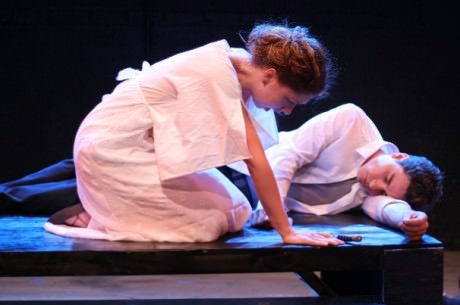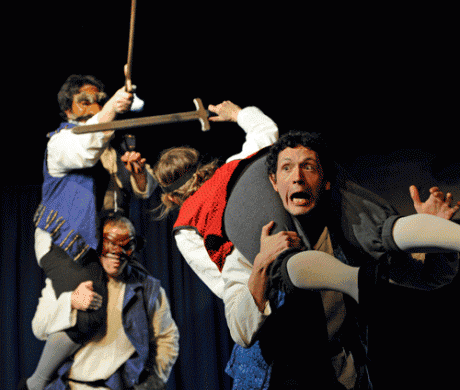F%#k you! (Not you, sorry! {I should probably have explained that statement a bit first]) The reason I said that is that it’s not something that you typically hear in a collaborative process (but you never know {I like to scream it at my cast mates on a regular basis just to keep them on their toes [I’m just cool that way]}). I know that this probably makes collaboration far less interesting than the things most Americans typically pay attention to (though I have no issue cursing more if that will keep you attentive). And while this may be true, I think that the topic deserves some attention. In a world that screams “me” at the top or their collective lungs, let’s try to have a discussion about “us.

In order to do this in a way that didn’t scream “me,” I invited several friends to help create this discussion (it was delightful!). In the home of new parents and Faction of Fools company members Lindsey Snyder and Paul Reisman (thank you for hosting), we came together. In addition to those two lovely people and myself we had Hannah Todd and Raven Bonniwell from We Happy Few Productions. The reason we thought that this group would be appropriate for a discussion is the fact that both companies are performing versions of Romeo and Juliet (I’m not going to bother mentioning the author {mostly because I don’t know who wrote it [but let’s keep that between us]}) that were created through collaborative processes.
We talked about collaboration in terms of the creation of the initial idea. We Happy Few began developing their concept for this Romeo and Juliet with four people creating the initial idea. After the basics had been discussed and defined they brought on many other artists as secondary collaborators to contribute to the whole. Faction of Fools began with about half a dozen artists developing the initial ideas and establishing the motivating forces before bringing in secondary collaborators to finish fleshing things out. So when we are discussing a separation between “collaborators” and “other artists” the divide is only indicative of the time they joined the process. And now that all the horses have been introduced let’s begin the race!

Collaboration is any process in which people come together to create something in a situation where every voice is heard and becomes a contributor to the finished product. I think those processes are wonderful, but even more wonderful is the process that includes all equally. These are very difficult to create, but can be created over time with trust and nurturing. Creating a truly collaborative process means that no one person has veto power, or that all persons do. The only way that works is if there is a massive trust in the room concerning the abilities of all the people involved. Having defined that, let’s look at what collaboration becomes in a real world process or two that includes living art, multiple iterations of performance, and shifting casts (This should be fun).
As we were discussing this subject we ranged over many topics (as any good discussion will) and we may visit some of those concepts in other columns, but for today we will stick to creation. One of the first ideas that popped out of the discussion was the concept that collaboration happens when you decide that there are people that you like (I, as a total misanthrope, will never understand this concept {though I hear it’s rather nice}). Now you enjoy these people so much that you decide you want an excuse to spend more time with them. And that’s when a new theatrical project suddenly comes to life. Seriously. We talked about this for quite a while and I actively tried to derail this idea specifically to see how strong it was. In both cases (Faction of Fools and We Happy Few) a small group of people said “You guys are awesome and we should make something because we have fun together!” This led to a discussion of what they would like to do and then they did it.
I think that this idea is one to hold up to the light and examine. There are so many facets of this that I find beautiful that I will discuss almost all of them (and by “almost all of them”, I mean one). A bond is discovered by two or more people and it affects them so deeply that they are moved to an act of creation. One of the many things that I discovered in this conversation is this new relationship that I had not given much thought. This idea of being drawn into one another’s orbits and using pieces of yourselves to fuel the creation of something new and unique was revelatory in its simplicity. Humans (in my opinion) have a specific, overriding drive to create. It seems to me that we begin to destroy when we are not permitted to indulge in creation.

A Commedia Romeo and Juliet plays TODAY at 8 PM and Sunday July 28th at 6:30 PM at Fort Fringe – The Shop – 607 New York Ave NW, Washington, DC. For performance times and to purchase tickets, visit the show’s Capital Fringe page.
LINKS
Review of Romeo and Juliet by Carolyn Kelemen on DCMetroTheaterArts.
2013 Capital Fringe Show Preview: ‘Romeo and Juliet’ by Kiersten Dittrich.
Review of A Commedia Romeo and Juliet by Jessica Vaughan on DCMetroTheatreArts.
Magic Time: ‘ We Happy Few Productions’ ‘Romeo and Juliet’ at Capital Fringe by John Stoltenberg.




